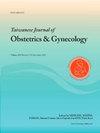双侧大量血性胸腔积液为卵巢过度刺激综合征的罕见表现:1例报告及文献复习
IF 2
4区 医学
Q2 OBSTETRICS & GYNECOLOGY
引用次数: 0
摘要
目的辅助生殖技术(ART)后可发生卵巢过度刺激综合征(OHSS)相关的肺部并发症。然而,血性胸腔积液极为罕见。我们报告一例接受抗逆转录病毒治疗并发展为OHSS的患者,随后出现双侧大量血性胸腔积液。一例32岁原发性不孕症妇女接受体外受精(IVF)治疗。取卵后,她以腹胀胸痛主诉到急诊科就诊。卵巢过度刺激综合征并发双侧大量血性胸腔积液(渗出)。她的d-二聚体开始升高,然后逐渐降低,她的呼吸急促有所改善。患者出院后无任何临床后遗症。结论ohss可导致危及生命的并发症,如胸腔积液,并在极少数情况下出现血性胸腔积液。卵母细胞回收后,升高的d-二聚体水平没有特定的诊断作用,应仅用于排除血栓栓塞事件。本文章由计算机程序翻译,如有差异,请以英文原文为准。
Bilateral massive bloody pleural effusions as a rare presentation of ovarian hyperstimulation syndrome: A case report and literature review
Objective
Pulmonary complications related to ovarian hyperstimulation syndrome (OHSS) can occur following assisted reproductive technologies (ART). However, bloody pleural effusions are exceedingly rare. We present a case of a patient who underwent ART treatment and developed OHSS, subsequently experiencing bilateral massive bloody pleural effusion.
Case Report
A 32-year-old woman with primary infertility underwent in vitro fertilization (IVF) treatment. After oocyte retrieval, she presented to the emergency department with a chief complaint of abdominal distention and chest pain. Ovarian hyperstimulation syndrome, complicated by bilateral massive bloody pleural effusion (exudative), was diagnosed. Her d-dimer was initially elevated, then decreased gradually, and her shortness of breath improved. The patient was discharged without any clinical sequelae.
Conclusion
OHSS can lead to life-threatening complications such as pleural effusion and, in rare cases, bloody pleural effusion. Following oocyte retrieval, an elevated d-dimer level has no specific diagnostic role and should only be used to rule out thromboembolic events.
求助全文
通过发布文献求助,成功后即可免费获取论文全文。
去求助
来源期刊

Taiwanese Journal of Obstetrics & Gynecology
OBSTETRICS & GYNECOLOGY-
CiteScore
3.60
自引率
23.80%
发文量
207
审稿时长
4-8 weeks
期刊介绍:
Taiwanese Journal of Obstetrics and Gynecology is a peer-reviewed journal and open access publishing editorials, reviews, original articles, short communications, case reports, research letters, correspondence and letters to the editor in the field of obstetrics and gynecology.
The aims of the journal are to:
1.Publish cutting-edge, innovative and topical research that addresses screening, diagnosis, management and care in women''s health
2.Deliver evidence-based information
3.Promote the sharing of clinical experience
4.Address women-related health promotion
The journal provides comprehensive coverage of topics in obstetrics & gynecology and women''s health including maternal-fetal medicine, reproductive endocrinology/infertility, and gynecologic oncology. Taiwan Association of Obstetrics and Gynecology.
 求助内容:
求助内容: 应助结果提醒方式:
应助结果提醒方式:


